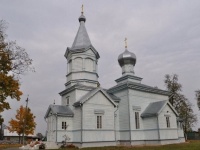- Home
- →
- Attractions
- →
- Church Prechistenskaya in Divin
Church Prechistenskaya in Divin
Divin Holy Protection Church is an outstanding monument of Belarusian wooden architecture, built in 1902. Located in the village of Divin, it is a unique example of church architecture with elements of the Neo-Russian style. This church has a rare destiny: throughout its more than century-long history, the temple has never been closed, making it one of the few religious buildings in Belarus to have preserved continuous spiritual life.
Today, the Holy Protection Church is a popular attraction included in the routes of many excursions around Belarus. As part of cultural and educational tours, including excursions from Minsk, travelers can learn about the history, architecture, and sacred treasures of the church.
History of Construction
The idea to build a new church in the village of Divin arose at the end of the 19th century when the local community aimed to create a spacious and beautiful church that reflected the spirit of the time. The construction of the Holy Protection Church was completed in 1902, and since then it has become the center of spiritual life for the surrounding villages. The church was consecrated in honor of the Most Holy Theotokos, which is reflected in its name.
The church is especially valuable because it survived the turbulent events of the 20th century without ever being closed. Even during the First and Second World Wars and the era of atheist policies under Soviet rule, the church remained open and welcomed parishioners. As a result, the authentic atmosphere has been preserved, and many interior elements have survived to the present day without loss. This makes the church not only an architectural but also a cultural and historical monument, attracting the attention of researchers and tourists alike.
Architecture and Spiritual Life
The Holy Protection Church was built according to the traditions of folk wooden architecture with elements of the Neo-Russian style, giving it a distinctive character. The main volume of the building is covered with a hipped roof, and the entrance is adorned with a low vestibule topped with a gable roof. The entire structure is dominated by a slender three-tiered bell tower, crowned with a tented roof and onion dome — a characteristic feature of church architecture of that period.
The church is clad in horizontal wooden planks and decorated with carved friezes and eaves, creating a festive and elegant appearance. The interior is designed in the traditions of Orthodox art: it features a hand-crafted wooden iconostasis and preserved rare icons from the 18th–19th centuries. Especially notable are the icons of “Venerable Onuphrius,” “Mother of God Hodegetria,” “Saint Nicholas the Wonderworker,” and “Nativity of the Theotokos.”
Divin Holy Protection Church is still an active place of worship. Regular services, church holidays, baptisms, and weddings are held here. For local residents, the church remains a vital spiritual center, and for pilgrims and tourists — a place of strength and inspiration.
Excursions with Church Visit
Divin Holy Protection Church is included in the routes of many excursions around Belarus, allowing visitors to explore the traditions of wooden architecture and Orthodox culture. Excursion tours to the church are popular among tourists interested in architecture, history, and spiritual heritage. It is possible to arrange excursions from Minsk, as well as individual trips in the region with a visit to the church and other attractions.
During the excursion, guests will hear a detailed story about the construction of the church, its architectural features, and the people associated with it. Tourists will have the opportunity to see the unique interior, rare icons, and possibly attend a service if it coincides with their visit.
On the website ekskursii.by, you can easily book an excursion with a visit to Divin Holy Protection Church by selecting a convenient date and tour format. Such excursions will be unforgettable, allowing you to feel the atmosphere of the past and connect with the living tradition of Belarusian spiritual architecture.

